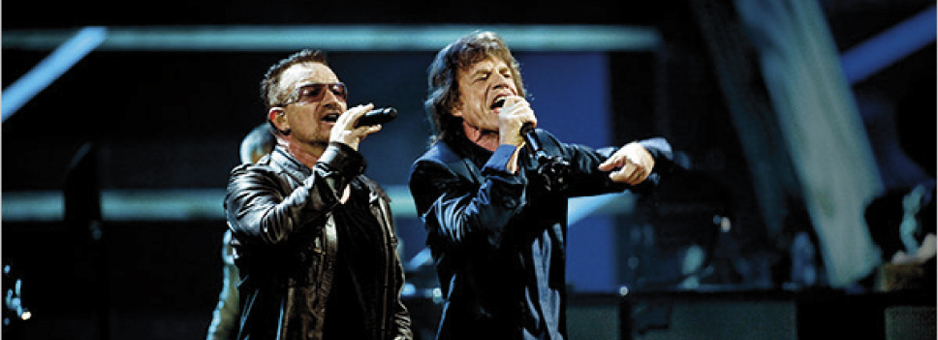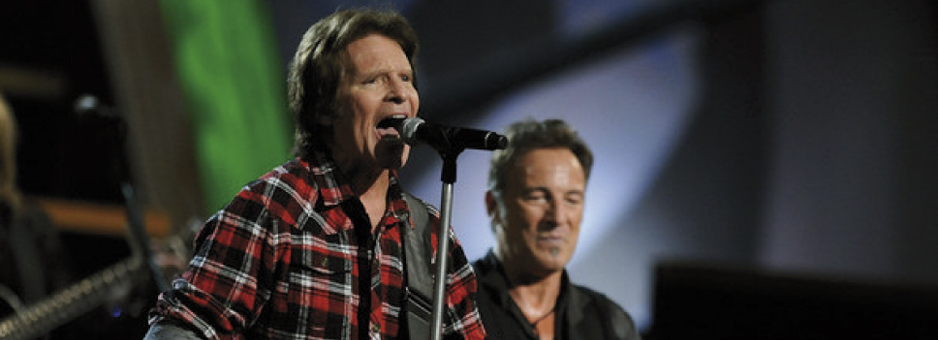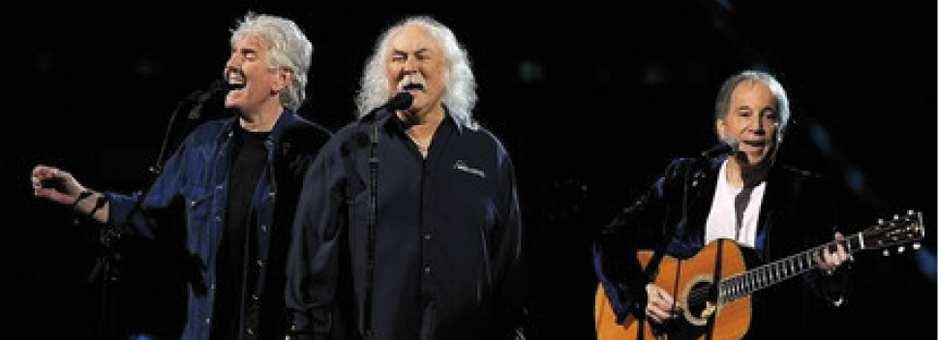Baselight helps Chainsaw rock the house
Chainsaw, Hollywood
Emmy-winning Hollywood post house uses its file-based workflow to edit, grade and conform landmark "Hall of Fame" concert for HBO.
HOLLYWOOD—The 25th Anniversary Rock and Roll Hall of Fame Concert, a 4-hour special that aired recently on HBO, documented a unique two-night event at New York's Madison Square Garden featuring many of the greatest stars in the history of rock. Unforgettable, cross-generational performances by Aretha Franklin and Annie Lennox; Metallica and Ozzy Osbourne; Bono, Mick Jagger and Fergie; Bruce Springsteen and Patti Smith; Simon & Garfunkel and Crosby, Stills & Nash, and many others made for a magical spectacle that wowed critics and delighted millions of music fans.
Magical is also an apt description of the effort that was carried out at Chainsaw, the Hollywood post house tasked with preparing the epic production for air. Presented with more than 100 hours of HD source material, the company leveraged its unique file-based workflow and pushed the limits of its newly-acquired Baselight colour grading system to complete the show in just two weeks while delivering a product whose style, polish and cinematic look rivals the best concert feature films.
Now in its 14th year, Chainsaw is one of few post houses to combine creative editorial and high-end editorial finishing under one roof and has enjoyed particular success in multi-camera television shows. (The company posts American Idol and has worked on the Academy Awards broadcast for many years, in addition to countless music and variety specials.) Recently, it also became one of Hollywood's first televsion post houses to implement a complete file-based workflow, with Avid Media Composer, Adrenaline, Symphony Nitris and DS Nitris systems, as well as Final Cut Pro offline and HD online finishing systems all connected to a central Avid Unity server.
Just last year, the company added colour grading to its mix of services, acquiring a Baselight HD and implementing FilmLight's new Baselight Kompressor technology to integrate the system into its Avid Unity shared storage environment. Colourists using Baselight can now share data and collaborate interactively with members of the facility's editorial team, resulting in a highly efficient and creatively-optimized end-to-end solution for projects of all sizes and scope.
"This great workflow gives us the ability to digitize at high resolution, conform in our Symphony Nitris systems and colour correct the same files in Baselight," explains Chainsaw co-founder and Emmy-winning editor Bill DeRonde. "Once Baselight embeds the colour, it's immediately available in the Symphony. The Symphony then has beautiful, colour corrected imagery to do titling and finishing. The Symphony plays the camera original media off the Unity, and so does Baselight. It's a new workflow."
The 25th Anniversary Rock and Roll Hall of Fame Concert was the latest in a long list of collaborations between Chainsaw and director Joel Gallen. Some 17 HDCAM cameras were used to record the performances, which began each night at 7 p.m. and ran until nearly midnight.
At the start of post, all of the original HD source material was ingested into Chainsaw's Avid Unity SAN. With the air date less than three weeks away, the creative editorial team had roughly the equivalent of two feature films to edit in just ten days. It was a tall order, but with the file-based workflow providing instant access to source media, the editors were able to work faster and focus most of their attention on the creative aspects of their task.
Their aim, according to DeRonde, was to capture the specialness of the event by giving the show the feel of a concert film rather than a television special. "The cut was a little different than what we usually do for television," recalls DeRonde. "We held shots longer. The pacing was slow and cinematic... we let shots play out, undercutting it to make it more filmic. We wanted people to see Bruce Springsteen, Mick Jagger, Bono. It was all about the artists on stage."
Even as work on the offline cut continued, colour grading and editorial finishing work was proceeding in other, interconnected suites. Colourist Andy Lichtstein, who joined Chainsaw when it purchased Baselight, performed the grade. Conform was completed by John Zimmer in an Avid Symphony Nitris. In order to make the project manageable, Lichtstein and Zimmer divided the show into seven acts. As Zimmer conformed each act, Lichtstein graded it. Lichtstein's graded sequences became immediately available to Zimmer for titling and other final finishing tasks.
Modest editorial changes continued to be made right up to the delivery point, but the workflow made such modifications simple. Individual shots were graded with handles allowing Zimmer to extend or trim scenes instantly. If a bigger change was required, Lichtstein simply graded the new shot and Zimmer dropped it into the cut.
"Because both processes were ongoing simultaneously, the producer could walk into the grading suite to view a sequence and make a decision, based on what he saw, to change something in the online process," explains Lichtstein. "He was essentially able to work interactively in online and colour with the same media. Previously, that would not have been possible."
Baselight's robust toolset allowed Lichtstein to assist Zimmer with certain types of "editorial" fixes, for example, eliminating cameras and crew from shots. "There were a lot of cameras, grips and cables on the stage and the director did not want to see them," Lichtstein says. "John painted 90 percent of them out, but when he couldn't get to it, he asked me to do it. I basically colour corrected them out."
Lichtstein used a similar procedure to modify the look of the concert hall environment, making 20,000-seat Madison Square Garden appear to be a much more intimate venue. "Joel Gallen didn't want to see the top of the arena," Lichtstein recalls. "Baselight has a wonderful edge correction tool with multiple layers and that allowed us to shape the picture and make the environment seem smaller and moodier. It was no longer the arena where the Knicks play, but was more like a club where you'd go to hear Crosby, Stills and Nash."
For Joel Gallen, this was his first time working with Baselight and he was impressed with the results. "The Rock Hall of Fame Concert was enriched greatly by the color correction we did at Chainsaw," Gallen says. "It was amazing working with their new Baselight device; every shot, close ups, wide shots, cross- shots, were enhanced beautifully. I received so many raves about 'how great the show looked' and I give the color correction process much of the credit for that."
Due to the project's tight deadline and because the workflow was so new, FilmLight provided on-site technical support to Chainsaw and as well as round-the-clock remote support via its international network of technical support engineers in order to ensure the project went smoothly and to quickly address any software issues that arose. "This was the first project of this scale to take advantage of this new workflow and FilmLight made a point to be here, to be part of the process and to help us make it work," Lichtstein recalls. "They were sensational."
Since completing The 25th Anniversary Rock and Roll Hall of Fame Concert, Chainsaw has employed Baselight on dozens of other projects ranging from feature films to television work of every description. That has made the company a good proving ground for Baselight's ability to integrate into a nonlinear, file-based editorial environment and handle anything that comes down the pipe.
"No one is using this new Unity-centric, multi-codec workflow to the extent that we are," observes DeRonde. "We work in 720/30p, 720/60p, 1080i 59.94, 1080i 50 and 1080/24p. One week, Andy worked in a different format every day. We're on Avid today, Final Cut tomorrow."
Flexible, file-based workflows may represent the future for most post houses, but at Chainsaw it's happening today. "Film is being shot less and less," DeRonde concludes. "Now, we are doing shows that are shot on files. We bring the files into our system, do the digital dailies and do the finishing—and the only time it goes to tape is when we output the master for air. It's a file-based workflow and we at Chainsaw are perfecting it."






